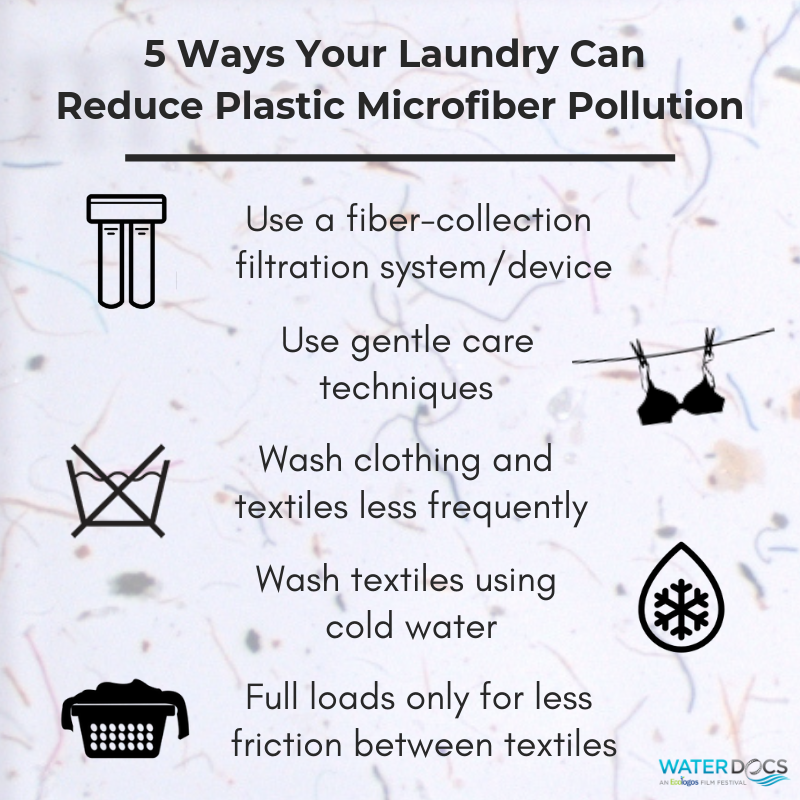Bans involving plastic bags, bottles, straws and cutlery are being implemented and celebrated worldwide. But there’s a smaller, more ubiquitous kind of plastic pollution that poses a bigger threat - and one that’s a little trickier to solve.
Synthetic microfibers are just one of many different forms of microplastics that are now invading waterways and ecosystems around the world. Microfibers are the tiny threads released from our synthetic, plastic-based clothing, furniture, carpets, cigarette butts and other textiles.
When we wash textiles made from synthetic materials in the washing machine, little tiny threads are released and exit our homes with the wash water where they travel to nearby wastewater treatment plants. There, they remain in the wastewater effluent that gets released directly into local watersheds, lakes and oceans. While the washing machine is not the only source of microfibre pollution, we know that it is a particularly significant source: in the city of Toronto, for example, it is estimated that as many as 23 to 36 trillion microfibers may be released into Lake Ontario watersheds each year from washing machines.
“In our own samples from the Laurentian Great Lakes, our research lab sometimes find more than 100 microfibers in an individual fish. Such widespread exposure raises concerns about effects to wildlife and human health.”
Given the extensive number of these minuscule escapees, it isn’t surprising in the least that microfibers have now been discovered in pretty much everything, from plankton to tap water to fish to turtles to table salt to beer to - wait for it, you knew this was coming - yup, HUMANS (brings a whole new level of meaning to the phrase eat my shirt, doesn’t it?). Water is life - and what you put into the water, you put into yourself.
While the solution to this problem is going to lie in widespread policies, regulations, bans and technological innovation, there are still some things we can all do right now to diminish the amount of microfiber pollution entering our waterways. Here’s how:
1) Use a fiber-collecting device in your washing machine. It’s kind of incredible really that washing machines do not come equipped with lint traps in the same way that dryers do and probably in the future, they will be. But since they aren’t currently, try a Lint LUV-R (you can find this made-in-Canada filter via Organic Lifestyle), a Cora Ball or a Guppyfriend bag (you can order these from Patagonia or directly from Guppyfriend website).
A recent study published in Marine Pollution Bulletin revealed the Lint LUV-R reduced microfibers in washing machine effluent by 87%, while the Cora Ball reduced microfibers by 26%.
2) Wash your clothes less frequently. Unless you’re running marathons on a daily basis, chances are that your clothes are still respectable enough for another wear. We live in a germaphobic, dirt-a-phobic culture and have grown accustomed to obsessively cleaning everything, all the time. The less often you wash your clothes, the less microfibers your clothes will shed. And the longer your clothes will last, meaning you won’t have to replace them as often.
If you want to freshen them up, get a clothing rack and hang them outside in the breeze (city humans consistently underestimate how AHmazing clothes smell after hanging outside. You can’t bottle that stuff). Getting in the habit of hang drying textiles is good practice anyway, as dryers are particularly hard on clothes.
3) Make sure you’re washing your clothes and textiles in a full load. The more room textiles have to move around in the wash, the more opportunity they have to rub against each other, causing friction that triggers more shedding.
4) Take care of your clothes! Choose a gentler wash cycle, a cooler temperature and skip the dryer. More aggressive wash cycles, higher temperatures and the high heat of the dryer all contribute to degrading and wearing out textiles faster. The more worn down materials become, the more microfibers they shed.
If you can invest in a good quality front-load washing machine - do it! These washing machines are much gentler on clothing than the older, top-loading ones.
5) Follow along and participate with organizations who are demanding that big industry and companies take responsibility for the microfiber pollution their products are generating. Like all forms of plastic pollution, there are currently very few laws that mandate companies foot the bill and put resources into cleaning up and preventing plastic waste. The Story of Stuff Project has an active campaign working to force clothing companies to attach a garment label informing consumers that laundering synthetic clothing in washing machines causes plastic fibers to shed.
This bill is an important first step towards solving the microfibers problem. By forcing manufacturers to own up to the pollution their products cause, the stakes are raised for them to find a lasting solution. And by passing this bill in California, they will be launching a scalable solution – just like the microbeads ban The Story of Stuff supported in 2015, which started as a state proposal before becoming federal law. Canada has also since banned microbeads.
All these problems feel so big, but if we all unite around taking #ActionForWater, small drops soon turn into an ocean and we can effect the real, significant change we need. Join us at the 2019 Water Docs Film Festival to learn all about the issues facing water and how you can take action through film, art, special guests and more!
Let’s flood the world with how we can take #ActionForWater and be the sea-change we want to see.
This is a guest blog from @itsahashtaglife – blogger, social media manager and content creator for non-profits and charities in Toronto. She takes the tools and techniques of traditional digital media marketing and applies them to organizations working hard to shift our world into a new story – one that is more sustainable and supportive of people and the planet.




